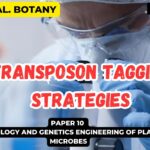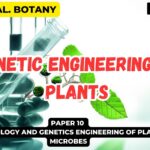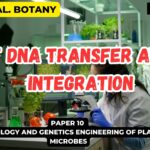![]()
Biosafety and Bioethics
- Biotechnology refers to any technique that uses living organisms or substances from these organisms to modify or improve quality and product of crops and food, drugs and health care products, vaccines, industrial chemicals and its products.
- It consists of gradient of technologies ranging from the widely used techniques of traditional biotechnology through modern biotechnology which is based on the use of new techniques of Recombinant DNA (r- DNA) technology, known as Genetic Engineering.
- Biosafety is one term that is used to describe the policies and procedures adopted to ensure the environmentally safe application of modern biotechnology.
- This is helpful in application of modern science in agriculture, medicine, and the environment, without endangering public health or environmental safety.
- Biosafety is the prevention of large-scale loss of biological integrity, focusing both on ecology and human health.
- These prevention mechanisms include conduction of regular reviews of the biosafety in laboratory settings, as well as strict guidelines to follow.
- Besides, biosafety is used to protect us from harmful incidents.
History
- The UNIDO, WHO, FAO, UNEP have built up an Informal Working Group on Biosafety due to growing concerns arising from GMOs throughout the world. In 1991, this group prepared the “Voluntary Code of Conduct for the Release of
Organisms into the Environment”. - The ICGEB has also played an important role in issue related to biosafety and the environmentally sustainable use of biotechnology.
- The ICGEB organizes annual workshops on biosafety and on risk assessment for the release of GMOs It collaborates with the management of UNIDO’s BINAS (Biosafety Information Network and Advisory Service), aimed at monitoring the global development in regulatory issues in biotechnology.
- Since September 1998, the ICGEB has provided an on-line bibliographic data-base on biosafety and risk assessment for the environmental release of GMOs.
- This database which is accessible through the website of ICGEB also provides informations on biosafety to its Member States.
- The ICGEB is also assisting to its Member States in developing the national biosafety framework, since February 1999, it has also adopted a legally binding biosafety protocols by the signatory countries.
Biosafety Committees
- The first step in developing appropriate policies and procedures for the regulation of biotechnology is to establish a national biosafety advisory committee.
- The national committee should then move quickly to establish policies and procedures to govern the use of modern biotechnology in the country.
1. National Biosafety Committee (NBC)
- An Egyptian National Biosafety Committee is being established, comprising policy makers and designers, scientific experts in Agriculture, Health, Industry and Environment from government and academic research institutes.
- The purpose of the national committee is to establish policies and procedures to govern the use of modern biotechnology in the country.
- This includes publishing the National Biosafety Committee guidelines (NBC Guidelines) to be followed at the national level.
- The committee would also provide technical advice to the regulatory authorities and the institutions responsible for the development of biotechnology in the country.
Activities of NBC
a) Formulate, implement and update safety codes
- In order to establish safety research policies, NBC shall formulate guidelines for both contained and uncontained applications to cover laboratory practices, greenhouse facilities, small scale field trials, and finally commercial release.
- This will include guidelines for research with natural organisms that are exotic to the host country.
b) Risk assessment and license issuance
- NBC takes initiatives to evaluate the benefits and potential risk of conducting research with modified organisms to the environment and to human community. If a license is issued after performing risk assessment analysis, NBC should periodically review containment measures and facilities to ensure that adequate safety guidelines are being followed.
c) Coordination with international and national organizations
- NBC would establish contact and maintain communication with international and national organizations, taking into account new scientific and technical knowledge as they evolve. It would also monitor changes in intellectual property rights issues at the national and international level.
d) Provide training and technical advice
- NBC is responsible that all personnel involved in biosafety issues receive adequate training on the most recent developments in safety procedures.
- It would also provide technical advice to the Institutional Biosafety Committees.
e) Report at least annually to governmental authorities
- An annual progress report would be submitted to governmental authorities covering NBC activities throughout the year.
2. The Institutional Biosafety Committee (IBC):
- The National Biosafety Committee should request that all institutions conducting R-DNA research assemble an Institutional Biosafety Committee.
- The IBC is responsible for ensuring that the r-DNA research is carried out in full conformity with the Provisions of the NBC Guidelines.
- As part of its general responsibilities for implementing the NBC Guidelines, the IBC may establish additional.
Biosafety Norms
- Biosafety norms includes Primary containment like standard lab practices ,use of safety equipment like Biosafety cabinets, sharp containers, ,sealed rotors and wearing of personal protective equipment-lab coats, gloves, goggles etc., use centrifuge with Biosafety covers, aerosol, sharp and needle precautions, limited access, biohazard warning sign, Sops for decon,waste,medicals.
- The main “topic of concern” related to the environmental release of GMOs are given below:
(i) Risks for human health toxicity and food quality/safety allergies, pathogens’ drug resistance i.e. antibiotic resistance
(ii) Risks for the environment persistence of gene or transgene or transgene products resistance of target organisms or susceptibility of non-target organisms increased use of chemicals in agriculture transgene instability unpredictable gene expression
(iii) Risks for agriculture weeds or superweeds alteration of nutritional value reduction of cultivars and loss of biodiversity
(iv) Risks of interaction with non-target organism’s genetic pollution through pollen or seed dispersal horizontal gene transfer transfer of foreign gene to microorganism i.e. DNA uptake generation of new line viruses by recombination.
(v) General concerns higher cost of agriculture loss of familiarity ethical issues, etc.
- With the potential future creation of man-made unicellular organisms, some are beginning to consider the effect that these organisms will have on biomass already present.
- Scientists estimate that within the next few decades, organism design will be sophisticated enough to accomplish tasks such as creating biofuels and lowering the levels of harmful substances in the atmosphere.
- Scientist that favour the development of synthetic biology claim that the use of biosafety mechanisms such as suicide genes and nutrient dependencies will ensure the organisms cannot survive outside of the lab setting in which they were originally created.
- Organizations like the ETC Group argue that regulations should control the creation of organisms that could potentially harm existing life.
- They also argue that the development of these organisms will simply shift the consumption of petroleum to the utilization of biomass in order to create energy.
- These organisms can harm existing life by affecting the prey/predator food chain, reproduction between species, as well as competition against other species (species at risk, or act as an invasive species).
- Synthetic vaccines are now being produced in the lab.
- These have caused a lot of excitement in the pharmaceutical industry as they will be cheaper to produce, allow quicker production, and as well enhance the knowledge of virology and immunology.
- The establishment of a National Biosafety System has become a necessity due to the introduction and the rapid increase of biotechnology applications in Egypt.
- Establishing a National Biosafety System and assuring compliance with biosafety regulations would:
1. Ensure that Biotechnology continues to be safe and does not expose employees, the community and the environment to any avoidable ill effects.
2. Facilitate access to modern biotechnology generated abroad, as many international institutions and companies will not test genetically engineered organisms unless the tests have been approved by a responsible governmental body.
3. Result in faster public acceptance and further development of modem biotechnology.
Fields of Biosafety Applications
- Biosafety as currently discussed in the International “Convention on Biological Diversity” (CBD) and designed to create internationally binding protocols on biosafety.
- The application of biotechnology to food and agriculture can bring not only potential risks and benefits as any technology can, but also concerns about the human dimensions coupled with biotechnology.
- These include both positive and negative impacts on stake holders, social institutions, economy and communities.
- Biosafety is related to several fields: In ecology it refers to imported life forms from beyond ecoregion borders, In agriculture it is reducing the risk of alien viral or transgenic genes, genetic engineering or prions such as BSE/”MadCow”, reducing the risk of food bacterial contamination. In medicine (referring to organs or tissues from biological origin, or genetic therapy products, virus; levels of lab containment protocols measured as 1, 2, 3, 4 in rising order of danger), In chemistry i.e., nitrates in water, PCB levels affecting fertility. In exobiology i.e., NASA’s policy for containing alien microbes that may exist on space samples – sometimes called “biosafety level 5″and in synthetic biology (referring to the risks associated with this type of lab practice.
- The international Cartagena Protocol on Biosafety deals primarily with the agricultural definition but many advocacy groups seek to expand it to include post genetic threats: new molecules, artificial life forms, and even robots which may compete directly in the natural food chain. When biological warfare or new, currently hypothetical, threats (i.e., robots, new artificial bacteria) are considered, biosafety precautions are generally not sufficient.
- The new field of biosecurity addresses these complex threats. Biosafety level refers to the stringency of biocontainment precautions deemed necessary by the Centers for Disease Control and Prevention (CDC) for laboratory work with infectious materials.
- Typically, institutions that experiment with or create potentially harmful biological material will have a committee or board of supervisors that is in charge of the institution’s biosafety. They create and monitor the biosafety standards that must be met by labs in order to prevent the accidental release of potentially destructive biological material. Biosafety fields include Assistance with Pathogen Acquisition, Biohazards Approval (New Grant/Subsidiary Grant/Instructional)Biosafety Registry (Application/Instructional).
Different areas associated with biosafety include:
(i) Agriculture and food system issues
(ii) Market and consumer issues
(iii) Institutional issues, business issues and
(iv) Social issues
Agriculture and food system issues–
- These include the impact of biotechnology on the organization, structure and behavior of agricultural industry; further, the coexistence of conventional organic and biotechnology oriented agriculture; the capacity of the food system to segregate genetically-modified commodity and product of specific markets; impacts on competitions involved, trade in agricultural commodities and the economical impacts of establishing oversight, standard regulations and public policies concerning biotechnology.
Market and consumer issues-
- These include various limitations which come to the rescue of consumer demand for overall against the products of agricultural biotechnology, the needs, desires and concerns of consumers in domestic and international markets; the influence of culture, advertising, product labeling, scientific information and recent new events on consumer decision making about the use of biotechnology products; different methods for most effectively increasing the understanding on which publication and primary decision making concerning biotechnology is based.
Institutional issues and business issues-
- These include the impacts of biotechnology on individual forms or group of forms about buying or selling biotechnology products and processes; changes in business practices, alliances and domestic and international markets including markets in Third World countries.
Bioethics
- Bioethics is the study of controversial ethical issues emerging from new situations and possibilities brought about by advances in biology and medicine.
- It is also moral discernment as it relates to medical policy, practice, and research.
- Bioethicists are concerned with the ethical questions that arise in the relationships among life sciences, biotechnology, medicine, politics, law, and philosophy.
- It also includes the study of the more commonplace questions of values which arise in primary care and other branches of medicine
- The field of bioethics has addressed a broad swath of human inquiry, ranging from debates over the boundaries of life (e.g. abortion, euthanasia), surrogacy, the allocation of scarce health care resources (e.g. organ donation, health care rationing) to the right to refuse medical care for religious or cultural reasons.
- Bioethics often disagree among themselves over the precise limits of their discipline, debating whether the field should concern itself with the ethical evaluation of all questions involving biology and medicine, or only a subset of these questions.
- The scope of bioethics can expand with biotechnology, including cloning, gene therapy, life extension, human genetic engineering, astroethics and life in space, and manipulation of basic biology through altered DNA, RNA and proteins.
- These developments will affect future evolution, and may require new principles that address life at its core, such as biotic ethics that values life itself at its basic biological processes and structures, and seeks their propagation.
- Similarly, medical ethics is the study of moral values and judgments as they apply to medicine which encompasses its practical application in clinical settings as well as work on its history, philosophy, theology, and sociology.
- Medical ethics tends to be understood narrowly as an applied professional ethics, whereas bioethics appears to have worked more expansive concerns, touching upon the philosophy of science and issues of biotechnology.
- Still, the two fields often overlap and the distinction is more a matter of style than professional consensus.
- Besides, it also shares many principles with other branches of healthcare ethics, such as nursing ethics.
- The term Bioethics (Greek bios, life; ethos, behavior) was coined in 1926 by Fritz Jahr, who “anticipated many of the arguments and discussions now current in biological research involving animals” in an article about the “bioethical imperative,” as he called it, regarding the scientific use of animals and plants. In 1970, the American biochemist Van Rensselaer Potter also used the term with a broader meaning including solidarity towards the biosphere, thus generating a “global ethics,” a discipline representing a link between biology, ecology, medicine and human values in order to attain the survival of both human beings and other animal species.
- The National Commission for the Protection of Human Subjects of Biomedical and Behavioral Research was initially established in 1974 to identify the basic ethical principles that should underlie the conduct of biomedical and behavioral research involving human subjects.
- However, the fundamental principles announced in the Belmont Report (1979) namely, autonomy, beneficence and justice have influenced the thinking of bioethicists across a wide range of issues.
- Others have added non-malificence, human dignity and the sanctity of life to this list of cardinal values.













